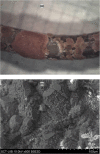Reduction of ureteral stent encrustation by modulating the urine pH and inhibiting the crystal film with a new oral composition: a multicenter, placebo controlled, double blind, randomized clinical trial
- PMID: 32503502
- PMCID: PMC7275439
- DOI: 10.1186/s12894-020-00633-2
Reduction of ureteral stent encrustation by modulating the urine pH and inhibiting the crystal film with a new oral composition: a multicenter, placebo controlled, double blind, randomized clinical trial
Abstract
Background: Encrustation of ureteral double J stents is a common complication that may affect its removal. The aim of the proposed study is to evaluate the efficacy and safety of a new oral composition to prevent double J stent encrustation in indwelling times up to 8 weeks.
Methods: A double-blinded, multicenter, placebo-controlled trial was conducted with 105 patients with indwelling double J stents enrolled across 9 public hospitals in Spain. The patients were randomly assigned (1:1) into intervention (53 patients) or placebo (52 patients) groups for 3 to 8 weeks and both groups self-monitored daily their morning urine pH levels. The primary outcome of analysis was the degree of stent ends encrustation, defined by a 4-point score (0 - none; 3 - global encrustation) using macroscopic and electron microscopy analysis of crystals, after 3 to 8-w indwelling period. Score was exponentially transformed according to calcium levels. Secondary endpoints included urine pH decrease, stent removal, and incidence of adverse events.
Results: The intervention group benefits from a lower global encrustation rate of stent ends than placebo group (1% vs 8.2%; p < 0.018). Mean encrustation score was 85.12 (274.5) in the placebo group and 18.91 (102.27) in the intervention group (p < 0.025). Considering the secondary end points, treated patients reported greater urine pH decreases (p = 0.002). No differences in the incidence of adverse events were identified between the groups.
Conclusions: Our data suggest that the use of this new oral composition is beneficial in the context of ureteral double J indwelling by decreasing mean, as well as global encrustation.
Trial registration: This trial was registered at www.clinicaltrials.gov under the name "Combined Use of a Medical Device and a Dietary Complement in Patient Urinary pH Control in Patients With an Implanted Double J Stent" with date 2nd November 2017, code NCT03343275, and URL.
Keywords: Double J stent; Encrustation; L-methionine; Nutraceutical; Phytin; pH.
Conflict of interest statement
Dr. Felix Grases certifies that all conflicts of interest, including specific financial interests and relationships and affiliations relevant to the subject matter or materials discussed in the manuscript is the following: Dr. Jordi Cuñé is a full-time employee at Devicare S.L. collaborating in the conception, design and revision of the manuscript.
The other authors have nothing to disclose.
Figures






References
-
- Finney RP. Experience with new double J ureteral catheter stent. J Urol. 1978;120(6):678–681. - PubMed
-
- González-Ramírez M, Méndez-Probst C, Feria-Bernal G. Factores de riesgo y manejo en la calcificación del catéter doble. J Rev Mex Urol. 2009;69(0155):7–12.
-
- Saltzman B. Ureteral stents. Indications, variations, and complications. Uro Clin North Am. 1988;15(3):481–491. - PubMed
-
- Stickler DJ. Clinical complications of urinary catheters caused by crystalline biofilms: something needs to be done. J Intern Med. 2014;276(2):120–129. - PubMed

